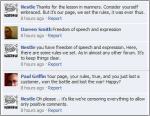Some people might be familiar with the term blogging and wonder what microblogging is.
According to wikipedia, “A microblog differs from a traditional blog in that its content is typically smaller in both actual and aggregate file size. Microblogs allow users to exchange small elements of content such as short sentences, individual images, or video links”.
Some examples of microblogging are Twitter, Facebook, pownce and Tumblr. Microblogging is different from the traditional blogging where it shares information with the readers immediately where people broadcasting short message. Sometimes it can als be in the form of images or video links to convey their messages. Two-way messaging is possible and people can give feedback and response.
From my previous blog post, I mentioned about how Singapore Airlines (SIA) have recently adopt the usage of social media. They uses microblogging (Twitter and Facebook) to send our information to their customers regarding their flight offers. Since they are new to microblogging, there are few things that they should keep in mind:
- Regular updates should be practice and this will tend to get more followers to read your post
- Link all the microblogs together so that people can know other updates and create interest
- Experience, Information and Business should be shared together in microblogging
- Get user involvement and always reply back to readers post
- Keep it real and authentic
- Think of what you are willing to share before you microblog because everyone can see it
- Add widget if possible, this will instantly show up wherever it is placed and add instant updates.
Microblogging will be a long term trend. The ease to post regularly are why people are attracted to it the most. It is the bred of blogging and acceptance by more people to this concept will make it more likely to be the next best thing to blogging alone.
References:
Wikipedia – Microblogging
Singapore Airline Website







